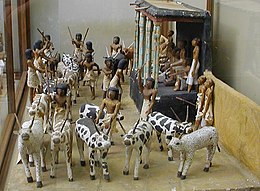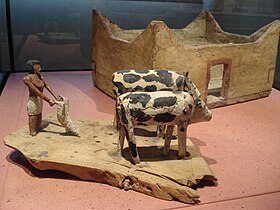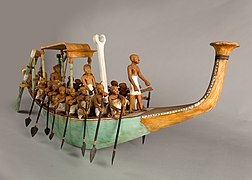Wooden tomb model

Wooden tomb models were deposited as grave goods in the tombs and burial shafts in Middle Kingdom of Egypt. They included a wide variety of wooden figurines and scenes, such as boats, granaries, baking and brewing scenes and butchery scenes.
Predynastic, Early Dynastic and Old Kingdom[]
Pottery and ivory models from the Predynastic and Early Dynastic periods are rare, but have been found to include similar items and scenes to the later models such as granaries.[1][2]
During the Old Kingdom, limestone models of single figures taking part in a variety of activities such as "sifting, forming dough cakes, attending a bread oven, straining beer mash, preparing beer jars, cooking or stewing meat, butchering a cow, and carrying pots or sacks," playing the harp, as well as several wooden boat models have been found in elite burials.[1][2][3] The models could be found buried outside of the tomb or in the serdab and statue niches within the tomb.[4] Following the reign of Pepi II, such models are increasingly found in elite burials and in greater numbers.[1]
First Intermediate Period and Middle Kingdom[]
The First Intermediate Period models were made of wood and were usually two or more human figures attached to a base in a scene.[1] Most funerary models today are from the Middle Kingdom, where not only did the number increase but also the variety of the models and their functions. These models could be found in the tomb chapel, for example the tomb of Nakhti at Asyut, floor niches and shafts, or in the burial chamber.[4] Those found in the burial chamber were orientated to the cardinal directions and coffin, and could be found both on top of the coffin and on the floor beside it. These models can be generally be grouped into boats, food production, craftsmen and workshops, and other (soldiers, scribes, house models, inspection of cattle and men holding a sedan chair).[5] Most of the models are three-dimensional representations of common scenes that are found on tomb chapel walls. For example, granaries are found depicted on southern walls of Old Kingdom tomb chambers and as well as on the foot ends of Middle Kingdom coffins.[6]
Some of the best known are the twenty-four wooden models come from the tomb of Meketre (TT280), are now found in the Egyptian Museum in Cairo and Metropolitan Museum of Art in New York City.[7] The largest collection of models were found in Tomb 10A of Djehutynakht and his wife, also called Djehutynakht, at Dayr al-Barshā by the 1915 the Harvard University-Boston Museum of Fine Arts excavation which included "some 58 model boats and nearly three dozen models of daily life."[8] These models are now at the Boston Museum of Fine Arts.[9]

Model of a procession of offering bearers, Tomb of Meketre. MMA 20.3.8.

Plowing scene. Louvre E 27069.

Model of a Cattle Stable, Tomb of Meketre. MMA 20.3.9.

Model of a Granary with Scribes, Tomb of Meketre. MMA 20.3.11
Late Middle Kingdom and New Kingdom[]

During the reign of Senusret III, the use of wooden models in tombs declines and are no longer found.[5] However, frequently included in discussions of Middle Kingdom models are several model boats have been found in New Kingdom royal burials, most notably the burial of Tutankhamun.[10] Tutankhamun's flotilla included thirty-five boats.[10] Other notable New Kingdom models are the boats of Queen Aahotep at Dra Abu el-Naga which includes one made of gold with silver figures and another made entirely of silver.[11]
Model boats[]
The Nile river was very important in ancient Egypt as it allowed for agriculture, trade, and travel. As with other model types, tomb wall paintings from the Old Kingdom onwards frequently included images of boats, with scenes of the manufacture of boats, pilgrimages to Abydos for festival days, transportation of the coffin, sporting and other activities.[9] In the corpus of model boats, similar motifs are reflected in three-dimensions, such as vessels for transporting the deceased, cooking, travelling, and sporting.[12] A typology of model boats was made by George Andrew Reisner in the 1913 catalogue of model boats at the Egyptian Museum, Cairo. He categorised the boats into seven types:
- Type I: Square cut river-boat, two rudders (Old Kingdom)
- Type II: River-boat with curling stern and single rudder (Middle Kingdom)
- Type III: Swamp boat, papyrus raft (Predynastic period down)
- Type IV: Papyrus-form wooden boat (Old to Middle Kingdom)
- Type V: Funeral bark of papyrus form (Middle Kingdom)
- Type VI: Solar bark of uncertain structural origin (Middle Kingdom)
- Type VII: Divine barks (All periods)[13]
In the Middle Kingdom, model sailing and rowing boats (type II or IV) were generally found in pairs, one rowing indicating travel northward, one sailing indicating travel southward.[9]

Model Paddling Boat, Tomb of Meketre. MMA 20.3.5.

Model Boat, Lisht. MMA 24.9

Model Sporting Boat, Tomb of Meketre. MMA 20.3.6.
References[]
- ^ a b c d Tooley, Angela M. J. "Models." In The Oxford Encyclopedia of Ancient Egypt. Oxford University Press, 2001. ISBN 0195102347. OCLC 163459051.
- ^ a b Tooley, Angela M. J. (1995). Egyptian models and scenes. Princes Risborough: Shire. p. 16. ISBN 0-7478-0285-8. OCLC 33360271.
- ^ Taylor, John H. (2001). Death and the afterlife in ancient Egypt. Chicago: University of Chicago Press. pp. 99–107. ISBN 0-226-79163-7. OCLC 45195698.
- ^ a b Tooley, Angela M. J. (1995). Egyptian models and scenes. Princes Risborough: Shire. pp. 13–14. ISBN 0-7478-0285-8. OCLC 33360271.
- ^ a b Grajetzki, Wolfram (2003). Burial Customs in Ancient Egypt : Life in Death for Rich and Poor. London. ISBN 0-7156-3217-5. OCLC 51738396.
- ^ Willems, Harco (1988). Chests of life : a study of the typology and conceptual development of Middle Kingdom standard class coffins. Leiden: Ex Oriente Lux. ISBN 90-72690-01-X. OCLC 20343577.
- ^ "Model Bakery and Brewery from the Tomb of Meketre". www.metmuseum.org. Retrieved 2021-03-19.
{{cite web}}: CS1 maint: url-status (link) - ^ "The Secrets of Tomb 10A". Museum of Fine Arts, Boston. Retrieved 2021-03-19.
- ^ a b c The secrets of Tomb 10A : Egypt 2000 BC. Rita E. Freed, Boston Museum of Fine Arts. Boston: MFA Publications. 2009. pp. 151–179. ISBN 978-0-87846-747-1. OCLC 449186077.
{{cite book}}: CS1 maint: others (link) - ^ a b Jones, Dilwyn (1990). Model boats from the tomb of Tutʻankhamūn. Oxford: Griffith Institute. ISBN 0-900416-49-1. OCLC 23582589.
- ^ Tooley, Angela M. J. (1995). Egyptian models and scenes. Princes Risborough: Shire. pp. 55–56. ISBN 0-7478-0285-8. OCLC 33360271.
- ^ Spanel, Donald B. (1985). "Ancient Egyptian Boat Models of the Herakleopolitan Period and Eleventh Dynasty". Studien zur Altägyptischen Kultur. 12: 243–253. ISSN 0340-2215. JSTOR 25150094.
- ^ Reisner, George Andrew (1913). Models of ships and boats. Le Caire: l'Institut français d'archéologie orientale.
Further reading[]
- Jones, Dilwyn (1990). Model boats from the tomb of Tutʻankhamūn. Oxford: Griffith Institute. ISBN 0-900416-49-1. OCLC 23582589.
- Reisner, George Andrew (1913). Models of ships and boats. Le Caire: l'Institut français d'archéologie orientale
- Tooley, Angela M. J. "Models." In The Oxford Encyclopedia of Ancient Egypt. Oxford University Press, 2001. ISBN 0195102347. OCLC 163459051.
- Tooley, Angela M. J. (1995). Egyptian models and scenes. Princes Risborough: Shire. ISBN 0-7478-0285-8.
- Digital Egypt - Wooden Models
- Examination of Wooden Tomb Models - Penn Museum
- Art of ancient Egypt
- Funerary art
- Sculptures of ancient Egypt
- Wooden sculptures
- Figurines
- Egyptian artefact types
- Ancient Egypt






